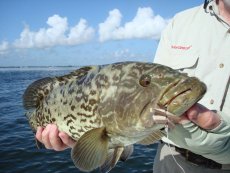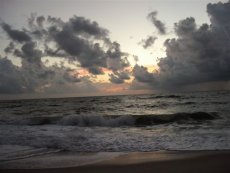Saltwater Fishing at its Best.
Used as a life line for carrying goods and supplies, migrating people, supplying fish, crabs and oysters, in years past, the Indian River—and specifically the area around Sebastian Inlet near Melbourne, Florida—in modern times is both a vital navigational section of the Intracoastal Waterway Canal that goes 4,800 km from south Florida to New Jersey; and a recreational source for boaters and fishermen. The area discussed in this article will include a few kilometers north and south of Sebastian Inlet, both in the Indian River and the Atlantic Ocean. This area is 1800 km south of New York City and 280 km north of Miami, Florida.
Sea turtles, manatees (sea cows, the animal from which the “mermaid myth” is supposed to have derived), bottle-nosed dolphin, bonnet-head sharks, and rays of numerous species all are available for viewing at different seasons and tides in this prolific section of the Indian River where salt water from the Atlantic Ocean meets and mixes with fresh water flowing east out of the Kissimmee chain of lakes 88 km (55 miles) to the west.
For the salt-water fly fisherman who likes a mixed bag of possible fish species to pursue, this section of the Indian River is the place to go. In the River itself, the following game fish are available to the fly fisher: snook, tarpon, jack crevalle, redfish, grouper and snapper species, and ladyfish. Motor a mile east under the Sebastian Inlet Bridge and ocean fishing is available. Here the speedy (capable of swimming 60 kph) “Bonito” or false albacore can be found chasing schools of glass minnows and menhaden. Spanish mackerel, cobia, kingfish, dolphin (also known as dorado and mahi-mahi) sailfish, and the rare white marlin cruise. Jumping sharks like the black-tip (also known as spinner-shark because of it’s peculiar but spectacular habit of rocketing straight up out of the water, whirling like a skater, then smashing back on the water’s surface to devour stunned fish) and the king of the shark performers—the mako, prowl the mouth of the inlet waiting for fish washed through on an outgoing tied.
Fishing the Indian River and its environs can be as simple as wading the shallows, and there are miles of them, and using a 5 wt. rod to cast a 1/0 hook Clouser minnow fly to small schools of 2-4 pound ladyfish; or there is the more complicated and expensive option of going for the big fish in the ocean where chum and live bait is used to bring the kingfish or black-tip shark within range of the flyfisher’s casting ability where he uses up to a 12 wt. rod, a wire or heavy monofilament leader (Note: the word “tippet” doesn’t apply when using such heavy terminal tackle) tied directly to a foot-long streamer.
Because the tide “flushes” the tannin-stained brackish water from the river, through the inlet, and into the ocean twice a day at low tide; and the ocean water returns to clear the river two times a day at high tide, there are always various fishing possibilities. The inlet is only dredged 3 meters deep, and gag grouper, mangrove and red snapper, and a host of smaller bottom-feeding fish hang off or near the trough created for the safe passage of boats. Sinking lines and even sink-tips will often get a crab imitation fly or Clouser minnow down to these fish. The flyfisher needs an 8-10 wt. rod with plenty of backbone to bring these fish to the net. The fight is often referred to as tugging with a bulldog. None of these bottom fish jump, but some make hard, powerful surges that require a good drag on the reel and a strong wrist and forearm.
Typical Flies: Clousers, Lefty’s deceiver, permit/bonefish crab and shrimp patterns, streamers. Silver, white, chartreuse, bright pink, and red/white colors can all work at certain times.
Fishing the area when the calico crabs are swimming is a special time, since all the game fish species in and around Sebastian inlet eat them. During this crab mating ritual, the normally secretive crabs swim with the current, looking for mates. Crab-imitation flies 8 cms (3 inches) across are tossed to sighted fish and drifted by them. The strikes can be savage as a 5 kgs (10 lbs) snook or 25 kgs (60 lbs) tarpon grabs a crab before one of its competitors takes the delectable morsel.
There is no fair comparison with the strength and fighting ability of freshwater fish with saltwater fish, with the exceptions being fish like salmon and steelhead that live in both waters. It’s important for the first-time saltwater fisherman to question his guide and/or travel agent before the trip so the client is physically and mentally prepared for what happens when a meter-and-a-half of silver tarpon feels the hook and leaps 3 meters out of the water. Imagine how quickly the backing is exposed on the reel when a swift jack slams into a silver streamer. There’s nothing like it.
The sun, salt air and salt water not only degrade fishing equipment quickly, but can quickly damage the fisherman, as well. Sun screen lotion is absolutely necessary. Large billed caps or hats, long-sleeved shirts, polarized sunglasses, face-covering bandanas/tube covers, and sun gloves are all important for even a few hours of fly fishing from an open boat. Boat or deck shoes with rubber bottoms designed for gripping are very important. Often the flyfisher is standing on a moving, rocking flush deck or raised casting platform. The purpose here is not to scare anyone from fishing the saltwater, but rather to insure the reader has an enjoyable experience.
For a variety of saltwater fishing experiences (shallow water sight fishing to open ocean casting into schools of baitfish) within a few kilometers, the Sebastian Inlet section of the Indian River is a premier fly fishing destination.
Contact Information
Guide:
Capt. Randy DuMars, Florida Saltwater Fishing Guide
Phone: 407.908.8498
E-mail: [email protected]
Lodging:
Sandy Shoes Resort
Phone: 321.723.5586
Sandy Shoes Resort is on the ocean and provides good surf fishing for pompano, bluefish, and whiting, depending on the season.
http://www.sandyshoesapartments.com/
Useful Links:
Sebastian Inlet State Park: http://www.floridastateparks.org/SebastianInlet/
Map of location of Sebastian Inlet (bottom right): http://www.floridastateparks.org/findapark/district-central.cfm
Sebastian Inlet Live Web Camera: http://www.sebastianinletdistrict.com/
Florida Map: http://www.mapquest.com/maps?state=FL















